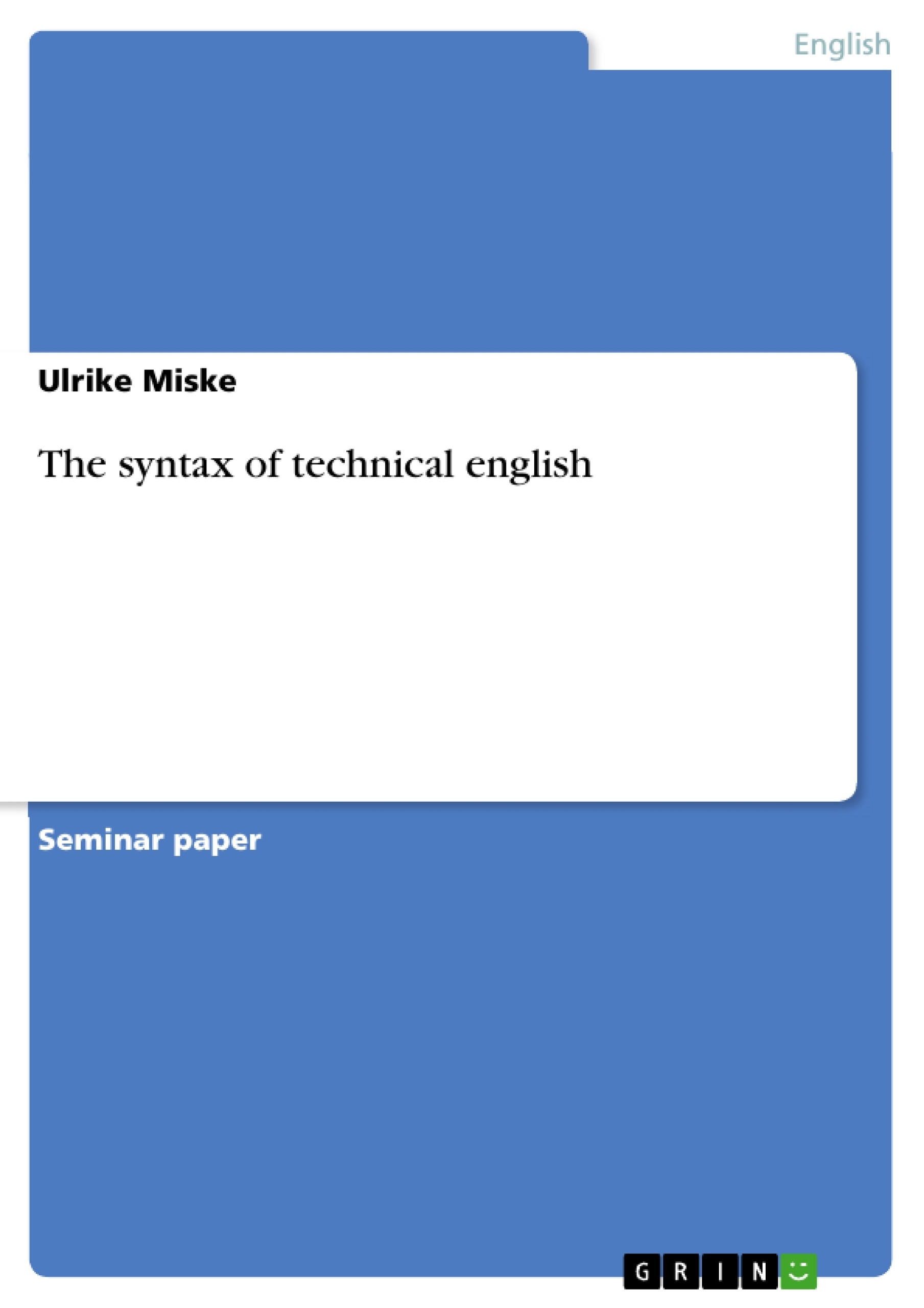Excerpt
Contents:
1. Introduction
2. Change in Syntax
2.1. Nouns
2.1.1. Nominalization
2.1.2. Zero Article
2.1.3. The s-genitive & Plural Forms
2.2. Verbs
2.2.1. Post-modifying Past Participles
2.2.2. Infinitive + »ing« as a Verbal Noun and after Prepositions
2.2.3. »NcI«-structure
2.2.4. Related Participle Construction
2.2.5. The Passive
2.2.6. Modal Verbs
3. Examples of Technical English
3.1. A report: The Preparation of Aspirin
3.2. A manual: Motorola Dimension 1000 Binary GSC Pager
4. Conclusion
5. Bibliography
1. Introduction
English has not only become one of the most important languages for communication but has also gained ground in science. Yet, when referring to technical English, we do not mean a completely new language but one that is based on the general grammatical and syntactical rules of the English language. Technical English is merely English for a special purpose. It serves to meet the need of communicating ideas, concepts, results in a very efficient way which is not limited to native speakers of English but easily understandable by all working in this field. Godrey/Parr[1] offer a good definition:
“The term ‘technical literature’ covers a wide variety of publications, all of which have as their object the conveying of information from one person to another. This information, to be of greatest use, must be conveyed as efficiently and as clearly as possible and herein lies the whole art of technical writing.”
Trying to convey information in an efficient and clear way, the question arises as to whether technical English shows certain characteristics to meet its purpose.
In this paper I will focus on the features of technical syntax and want to answer the question of how technical English achieves its purpose of being clear and efficient. I restricted my investigations to syntactical features concerning nouns and verbs. Using a variety of examples and texts I will furthermore prove how technical English tends to shortness, preciseness as well as comprehension by omitting any creative, literary paraphrasing.
2. Change in Syntax
2.1. Nouns
2.1.1. Nominalization
Nominalization is a very important means of condensation. It facilitates a more rational, precise and efficient transfer of information. In the field of technical English nouns also serve the purpose of being more measurable as verbs are regarded as too vague.
The following examples[2] serve to illustrate the common use of nominal expressions:
Ex. 1: “post-weld cleaning” instead of “to clean after the welding”
Ex. 2: “Heavy rain causes flooding” instead of “When the rain is heavy, the water
comes up high and spills over the banks”
“Post-weld cleaning”, for example, is much more likely to be used than “to clean after the welding”. With the deletion of the verb “clean” and the preposition “after” as well as the insertion of the prefix “post” the phrase “post-weld cleaning” is more rational and precise. And what is more, as a syntactical unit it can easily be excised and inserted into a different part of the sentence. Furthermore, example 2 shows that nominalization facilitates an efficient way of transferring information. “Heavy rain causes flooding” is not only more likely to be used but is also highly efficient as it reduces the length of the phrase to a minimum. The meaning, however, is still the same.
Moreover, Manfred Gerbert[3] suggests that it is how engineers function and their mindset which allows the engineer to associate the activities with the relevant piece of equipment (such as to cut – a cutting tool). He points out that there is a certain preference for speaking of operations and processes in technical English, neglecting the verbal expressions the processes are based on.
Another phenomenon to be detected in connection with nominal constructions is the common use of functional verbs, which have a neutral or little meaning such as in the following example:
Ex. 3: “Feed is effected by an air-hydraulic system”
instead of “The tool or workpiece is fed by an air-hydraulic system”
The second version of the sentence is more likely to be used outside of the technical English context. “Feed + functional verb ( effect) + air-hydraulic system” is a very condense way of describing the process, which is happening. The original subject is omitted and the passive “is fed” is turned into the new subject “feed”. This achieves an extensive reduction as only the core information is kept.
Furthermore, the nominalization tendency promotes the increase of ‘of-phrases’. Just as in the other examples above, it is the verb which is being nominalized:
Ex. 4: “the cooling of the engine is achieved by…”
instead of “the engine is cooled by…”
To sum up, there is a general tendency in technical English for an increase of nominal forms processing a decline in verbal forms.
[...]
[1] cf. Gerbert, Manfred. Besonderheiten der Syntax in der technischen Fachsprache des Englischen (Halle/Saale:
Max Niemeyer Verlag, 1970), p 25.
[2] cf. Gerbert, Manfred. Besonderheiten der Syntax in der technischen Fachsprache des Englischen, p. 36.
[3] Ibid., p. 37.
- Quote paper
- Ulrike Miske (Author), 2007, The syntax of technical english, Munich, GRIN Verlag, https://www.grin.com/document/115291
Publish now - it's free






















Comments